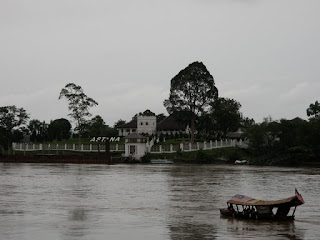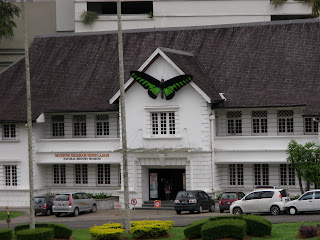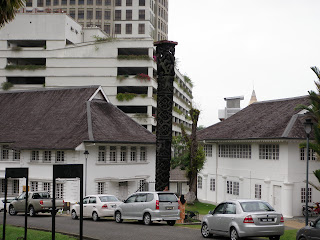Kuching - the capital of Sarawak is one of the most delightful cities in Southeast Asia. It has retained its 19th-century indentity in parts.
The people of Kuching are among the friendliest and most tolerant people in the world.
Cat Monument - the symbol of Kuching City:
Semenggoh Nature Reserve:
Annah Rais Bidayuh Longhouse:
Padawan Pitcher Plant and Wild Orchid Garden:
Sarawak Pottery Factory:
The Spring Shopping Mall:
Boulevard Shopping Mall:
Kolo Mee - a notable local dish:
Mount Santubong:
Sarawak Cultural Village:
(at Santubong Peninsula near Damai Beach, 35 km from Kuching)
Damai Bay and Hornbill Statue:
Kuching North City Hall:
(which houses the Cat Museum)
Cat Museum:
Kek Lapis Store:
Outside the Kek Lapis Store:
Orchid Garden:
Fort Margherita:
(a charming tower that now functions as the Police Museum)
(with view of part of the Main Bazaar; there are quaint cafes, restaurants, antique shops and art galleries housed in 19th Century Chinese shophouses)
Dewan Undangan Negeri of Sarawak:
(The New Sarawak State Legislative Assembly Building)
(The latest icon of Sarawak, view from Sarawak River
- a palatial architectural mammoth whose design was inspired by the traditional straw hats worn by the indigenous Melanau tribe)
Astana:
(view from Sarawak River, a grand colonial mansion with sprawling gardens)
The riverbank has been rejuvenated as the Waterfront and is recognized as one of Asia's finest public spaces and urban regeneration projects. It features tree-lined gardens, an esplanade, solar-powered lights, historic plaques, performance spaces, sculptures and musical fountains.
Malay Kampung:
Pink Mosque:
Brooke Dockyard:
Old City of Kuching:
Dewan Undangan Negeri of Sarawak:
(Inaugurated in 2009)
Natural History Museum:
(above its entrance is a model of the Rajah Brooke's Birdwing butterfly (Trogonoptera brookiana, a scarce and handsome species with a wing span of up to 17 cm)
Museum of Ethnology:
Outside the museums:
Four Points by Sheraton:
Multicultural Sarawak:
It is the most culturally diverse state in Malaysia. Iban (29%), Chinese (25%), Malay (22%), Bidayuh (8%), Melanau (6%); other Dayak groups (5%)
Virtually all Malaysa and about half of the Melanau are Muslims
The vast majority of other Dayaks and many Chinese belong to various Christian denominations.
Eat:
Top Spot Food Court (Jln Padungan): a perennial favourite among locals and visitors, a lively , neon-lit courtyard and its half-a-dozen seafooderies sits in the roof of a concrete parking garage. Try giant lobster, abalone, banana prawns, grilled white pomfret, chilli crab, butter prawn, steamed garoupa, oyster pancake.
Look for Ling Loong Seafood (store 6)
Open-Air Market (Jln Khoo Hun Yeang): the best hawker centre in town; try laksa, Chinese-style mee sapi (beef noodle soup), red kolo mee (noodles with sweet barbecue sauce), tomato kway teow (rice-noodle dish) and shaved ice desserts.
Yang Choon Tai Hawker Centre (Jln Carpenter): there are some brilliant food stalls, run by members of the Teochew Chinese community, directly opposite Hiang Thian Siang Temple. Try kolo mee (flash-boiled egg noodles) with seafood and cha siew (BBQ pork), rice porridge with pork and laksa.
Shop:
Satok Weekend Market: Kuching's biggest and liveliest market (noon-10pm Sat, 6am-1pm Sunday)
Excursions from Kuching:
Niah Caves - at Niah National Park in Miri, it is one of the birth places of human civilization, and the mammoth caves have prehistoric paintings and exhibits of primitive tools used by the inhabitants to harvest bird nests. There are also jungle trails exploring, Iban longhouses visiting and mountain climbing.
Gunung Mulu National Park - Sarawak's premier national park, home to 20,000 animal and 3,500 plant species. Located here is the largest limestone cave system in the world. For novice cave explorer, consider Deer Cave or Clearwater Cave (the longest cave in Southeast Asia). Seasoned explorers go for Black Rock Cave and Sarawak Chamber (the world's largest underground chamber). There is also hiking to the pinnacles of Gunung Api or Gunung Mulu.
Interest facts:
the Rhinoceros Hornbill is the State bird of Sarawak, where it is called Kenyalang.
See Also:
http://swytravel.blogspot.sg/2011/11/2011-brunei.html
http://swytravel.blogspot.sg/2010/01/2010-kota-kinabalu-sabah.html
Straits Times Travel Article on 8/4/2014:
Straits Times Travel Article on 21/8/2012:













































